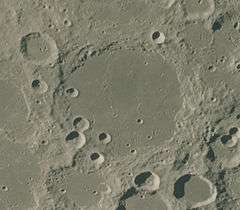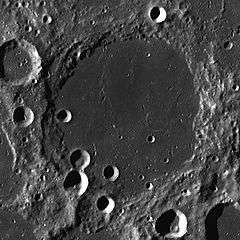Lyot (lunar crater)
Lyot is a large lunar impact crater that is located along the southeastern limb of the Moon. It lies within the irregular and patchy lunar mare named Mare Australe, and to the south of the crater Hamilton. Due to its location, this formation is viewed at a low angle from the Earth, and its visibility is affected by libration.
 Apollo 15 image | |
| Coordinates | 49.8°S 84.5°E |
|---|---|
| Diameter | 132 km |
| Depth | Unknown |
| Colongitude | 279° at sunrise |
| Eponym | Bernard F. Lyot |

The interior floor of this crater has been resurfaced by lava, leaving a dark interior with an albedo that matches the surrounding mare. The outer rim is low and heavily worn, with a perimeter that forms a somewhat distorted circle. The southwest part of the floor and rim is marked by several small, bowl-shaped craters. There is also the remains of a ghost crater to the east of the crater midpoint.
Satellite craters
By convention these features are identified on lunar maps by placing the letter on the side of the crater midpoint that is closest to Lyot.
| Lyot | Latitude | Longitude | Diameter |
|---|---|---|---|
| A | 49.0° S | 79.6° E | 38 km |
| B | 50.4° S | 82.2° E | 9 km |
| C | 50.4° S | 80.4° E | 17 km |
| D | 51.6° S | 82.2° E | 14 km |
| E | 52.0° S | 82.9° E | 13 km |
| F | 52.3° S | 82.8° E | 21 km |
| H | 51.4° S | 78.2° E | 63 km |
| L | 54.4° S | 83.1° E | 70 km |
| M | 53.3° S | 86.2° E | 24 km |
| N | 52.8° S | 83.4° E | 12 km |
| P | 47.7° S | 85.0° E | 13 km |
| R | 46.1° S | 87.6° E | 30 km |
| S | 46.0° S | 85.6° E | 26 km |
| T | 46.8° S | 78.6° E | 8 km |
References
- Wood, Chuck (2007-01-08). "A Dome on the Limb". Lunar Photo of the Day. Archived from the original on 2007-09-27. Retrieved 2007-01-08.
- Andersson, L. E.; Whitaker, E. A. (1982). NASA Catalogue of Lunar Nomenclature. NASA RP-1097.CS1 maint: ref=harv (link)
- Blue, Jennifer (July 25, 2007). "Gazetteer of Planetary Nomenclature". USGS. Retrieved 2007-08-05.CS1 maint: ref=harv (link)
- Bussey, B.; Spudis, P. (2004). The Clementine Atlas of the Moon. New York: Cambridge University Press. ISBN 978-0-521-81528-4.CS1 maint: ref=harv (link)
- Cocks, Elijah E.; Cocks, Josiah C. (1995). Who's Who on the Moon: A Biographical Dictionary of Lunar Nomenclature. Tudor Publishers. ISBN 978-0-936389-27-1.CS1 maint: ref=harv (link)
- McDowell, Jonathan (July 15, 2007). "Lunar Nomenclature". Jonathan's Space Report. Retrieved 2007-10-24.CS1 maint: ref=harv (link)
- Menzel, D. H.; Minnaert, M.; Levin, B.; Dollfus, A.; Bell, B. (1971). "Report on Lunar Nomenclature by the Working Group of Commission 17 of the IAU". Space Science Reviews. 12 (2): 136–186. Bibcode:1971SSRv...12..136M. doi:10.1007/BF00171763.CS1 maint: ref=harv (link)
- Moore, Patrick (2001). On the Moon. Sterling Publishing Co. ISBN 978-0-304-35469-6.CS1 maint: ref=harv (link)
- Price, Fred W. (1988). The Moon Observer's Handbook. Cambridge University Press. ISBN 978-0-521-33500-3.CS1 maint: ref=harv (link)
- Rükl, Antonín (1990). Atlas of the Moon. Kalmbach Books. ISBN 978-0-913135-17-4.CS1 maint: ref=harv (link)
- Webb, Rev. T. W. (1962). Celestial Objects for Common Telescopes (6th revised ed.). Dover. ISBN 978-0-486-20917-3.CS1 maint: ref=harv (link)
- Whitaker, Ewen A. (1999). Mapping and Naming the Moon. Cambridge University Press. ISBN 978-0-521-62248-6.CS1 maint: ref=harv (link)
- Wlasuk, Peter T. (2000). Observing the Moon. Springer. ISBN 978-1-85233-193-1.CS1 maint: ref=harv (link)